Cite this document
(“How would you Distinguish the Notions of Plaisir and Jouissance and Essay”, n.d.)
How would you Distinguish the Notions of Plaisir and Jouissance and Essay. Retrieved from https://studentshare.org/literature/1554864-media-tv-and-entertainment-see-bottom-of-attached-film-to-choose-a-question
How would you Distinguish the Notions of Plaisir and Jouissance and Essay. Retrieved from https://studentshare.org/literature/1554864-media-tv-and-entertainment-see-bottom-of-attached-film-to-choose-a-question
(How Would You Distinguish the Notions of Plaisir and Jouissance and Essay)
How Would You Distinguish the Notions of Plaisir and Jouissance and Essay. https://studentshare.org/literature/1554864-media-tv-and-entertainment-see-bottom-of-attached-film-to-choose-a-question.
How Would You Distinguish the Notions of Plaisir and Jouissance and Essay. https://studentshare.org/literature/1554864-media-tv-and-entertainment-see-bottom-of-attached-film-to-choose-a-question.
“How Would You Distinguish the Notions of Plaisir and Jouissance and Essay”, n.d. https://studentshare.org/literature/1554864-media-tv-and-entertainment-see-bottom-of-attached-film-to-choose-a-question.


